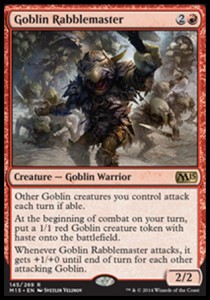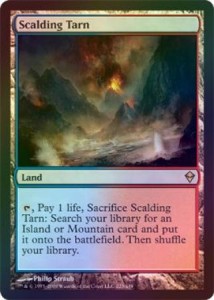
Welcome back, individual readers of BrainstormBrewery.com who conjure currency (or cards) based on the information in this weekly column. If you didn’t get a chance to read last week’s article, I highly recommend it. If you’re either in the market for dual lands, or getting maximum value out of dual lands that you currently own, you can secure some useful information there. Without wasting any more time (this is a segue, I swear), let’s go back in time even further to two months ago when I reviewed M15. Spoiler Alert: my review was almost entirely incorrect. I predicted almost every card in the set to plummet in value, when in reality almost all of them stood their ground or even increased in value.
Looking Back
I said back then that I would do a “review of my review” during this week of Conjured Currency, which allows (forces) me to look back at my now cringe-worthy predictions and analyze what went wrong, and where I could change my behavior or thinking for the future.
Let’s get this out of the way so I can talk about something that I think is much more interesting and useful. My predictions for M15 were…less than accurate. I overestimated the amount of the set that would be opened, and my lack of ability to properly evaluate Standard-playable cards ended up costing me my one-way ticket on the [card]Goblin Rabblemaster[/card] hype train. M15 was a breath of new life into the concept of core sets, but that didn’t prevent the community from giving it a large, “Meh,” as we anxiously await the destruction of all core sets once and for all. As such, there was a lot less of M15 product opened. Nissa and Garruk destroyed all that I knew and loved, and they maintain (or are higher than) their preorder prices. The same can be said for almost every rare/mythic in the set.
Looking Forward
That’s all I have to say about M15 this week. I don’t want to bore you with a repeat mini paragraph of every single card of, “This is why this prediction sucked. And this is why THIS prediction sucked.”
“But DJ, how will this help you prepare for the future?” Well, nameless voice that asks rhetorical questions, I’m glad you asked. I personally took this stance quite a while ago—ever since I got stuck with more than 40 copies of [card]Ghave, Guru of Spores[/card] that I correctly called but was unable to actually profit off of. I’m done with speculating. Yep.
Well, let’s give a more operational definition. Ever since May of 2014, I’ve officially stopped buying cards for the purpose of awaiting their price increase to sell at a later date. I’ll still trade random jank for other random jank that I believe has more potential, but no more buying out SCG of singleton Commanders that end up tripling in price with zero outs in sight.
There’s too much risk involved, with so very little room for reward other than being able to say, “Called it!” at my LGS. Your order has to not get cancelled (which, let’s be honest, has been happening more and more lately), the card has to double or sometimes triple for you to even make a semblence of a profit, and you have to liquidate your copies before everyone else in the world races to do so at the same time, or else you’re left with a pile of hot garbage.
Speculating is the Worst Thing Ever
Well, it might not be, at least for you. I just made it sound like it was, because of a few of my personal experiences with that particular MTG finance method. I’ve had my fair share of wins (PT Theros paid for a year of my Quiet Speculation subscription with [card]Master of Waves[/card], [card]Nykthos, Shrine to Nyx[/card], and [card]Thassa, God of the Sea[/card]), and my share of losses (RIP [card]Duskmantle Seer[/card]—never forget). However, it’s just not my thing anymore. I don’t play competitively enough (read: at all) to keep up to date on the constantly shifting metagame of Standard or Modern, so I don’t recognize the potential for new tech when it exists. My “new card evaluation” skills are obviously lacking.
However, each of our individual cases is different. When I first started writing for Brainstorm Brewery, I realized that it would be difficult for that exact reason. I’m writing to a crowd generally interested in MTG finance, but that can mean entirely different things to two people. On one hand, you might be ready to open up your own store and have tens of thousands of dollars to spend on collections using techniques that I teach in my articles. On the other hand, you might be barely scraping the cards together for a tier-two Standard deck to play at FNM. Our goals in MTG finance can be different, and so can our methods.
Speccing is the Best Thing Ever
And it is, especially for me. Wait, wha..? Yeah. Speccing. Spec(ialization). See what I did there? This entire article so far lead up to that pun. I’m throwing spec(ulation) to the wind, and I’m going to try and focus on a fewer, more concentrated aspects of Magic finance that I tend to do better in. For me, that’s collection buying, selling on social media, picking bulk, buying singles at buylist prices locally, and selling locally at TCG low. Yes, I just realized I started a paragraph about specialization and listed five different tactics, but you get the picture. I’m working on condensing my area of expertise, and cutting off the dead weight where I don’t tend to do well. And you know what’s great? This is customizable for you as well, whoever you are.
Maybe you’re awful at recognizing the nitty-gritty dime and quarter cards in a 5000-count box of commons and uncommons, but you’re a legendary Standard grinder, and can pinpoint the exact card in Khans of Tarkir that’s going to be the next [card]Courser of Kruphix[/card]. In that case, go for it and buy as many of that card as your piggy bank will allow. If you’re confident in your outs and your ability to predict the Standard metagame, then ignore everything I said about speculating and focus on your area of specialization that nets you the most coin.
In order for this to work out for you, it takes a good amount of self-analysis. Cleanse yourself of that cognitive dissonance and open your eyes to your strengths and weaknesses. Take a good look at the last collection you bought, or the last buylisting adventure you undertook. Were you able to maximize your profits? Did everything go according to plan?
Also, don’t be afraid to dabble. If you’re new to the wonderful world of Magic finance and have never bought a collection before, head on over to Craigslist and discover the wonderful world of people asking $400 for a box of water-damaged Fifth Edition commons (I say that, but there are some gems there if you check consistently enough. Use Google Chrome Page Checker or something similar to get updates about new listings). Learn what you’re good at, and learn what you’re not so good at. It takes practice, and it takes trial & error.
What’s your Spec?
Not a card to spec on, but what’s your area of specialization in Magic finance? I’ve personally had the best luck with buying and sorting collections, because it requires the least amount of knowledge about the current Standard/Modern metagames, and I’ve always felt at home with a box of unpicked commons and uncommons.
Bonus Round
If you’re still with me, I’d like to share a story about the most recent collection I just bought. After discussing the collection a bit with the seller over text, I learned that he was a casual player who had never attended a tournament in the 15 years he’d been playing the game. Awesome. I love casual players. After flipping through binders of rares and uncommons, it was clear to me that this man had no idea what any of his cards were worth. He had toploader-ed all of his Mythics, but proxied them in his unsleeved decks proudly labeled “ANGELS” “DEMONS” “VAMPIRES” “ASSASSINS”, etc.
While going through the land binder, I saw a [card]Sunpetal Grove[/card] or two, some bulk rares, a couple of shock lands, and… a foil [card]Scalding Tarn[/card]. Unsleeved. In mint condition. Obviously never touched. I immediately asked for a sleeve, and informed him of the find. I told him that the card was worth nearly $200 retail, and was surprised to see it hanging around unsleeved. Since he played casually, he never saw the point of paying one life for a land. That, and he never made a UR deck so he didn’t need it.
When it came time to discuss the price of the collection, I had found tons of additional goodies during my quick scan of the binders and mythics. I did some quick mental math after estimating the bulk commons and uncommons, and threw out a number. “How’s $700 for everything?” I wasn’t about to go higher, considering that was all of the money I had brought, not expecting a nice piece like this. He replied, “How about… $600? I want to thank you for being honest with me about the cards in this collection. You could’ve totally ripped me off, because I don’t know a damn thing about card prices. You handled this truthfully and professionally, and I appreciate that.”
Honesty pays, even literally sometimes. Until next week.
5 comments on Conjured Currency #31: Spec…ialization
Leave a Reply to Douglas Johnson Cancel reply
You must be logged in to post a comment.





Randomly picking cards to go up is horrible. Just like Random stock picking.
Play the game, see the impact cards, and go get them. Anyone who knows Magic, and reads the wall of text on Courser knew it was a good card. There’s 4-5 good cards in Khans (not counting fetches) that are known good to players, I will be picking up multiple play sets.
NO GAMBLING involved. Good cards go up.
If it was true that “anyone who knows Magic, and reads the wall of text on Courser knew it was a good card”, then it wouldn’t have spent its entire pre-sale price/week of release at $5. It took a while before people realized the power of the card and how it would affect the Standard metagame. It’s entirely possible that the card could be printed in a different Standard set where it would be a bulk rare. “Good cards go up” isn’t a good rule to follow. There are a ton of cards that are obviously “good” on a power level, but didn’t see enough Standard play due to metagame issues. See Advent of the Wurm for example; A four mana 5/5 with trample at instant speed that was printed in a minimally opened 3rd set. Price throughout Standard? Barely $1. However, if it had been printed in an alternative time, it could very well have been a chase rare of the set.
I agree with Gurg – my specs for the last 15 months were Young Pyromancer, Blood Scrivener (ugh), Voice of Resurgence (that hardly counts), Master of Waves (preordered ten playsets for twenty dollars a playset two weeks before Theros prerelease), Keranos (again, the wall-of-text was a dead giveaway), Xenagos (was buying them for ten dollars), and Mana Confluence (again, buying for eight dollars).
I am a fervant standard player; and I understand the format. When Innistrad rotated out, I saw immediate parallels in Master of Waves and went all-in. I sold them individually for the price at which I bought playsets. If you don’t understand standard, you have very little role speculating in MTG as you’re uninformed of the biggest driver of prices. I don’t make much money off of magic, as it’s my hobby, but I always come out with more than I put in every standard season because it’s low-risk to identify standard playables. If you can’t reliably do that, you’re going to be upset with your specs.
@ Douglas – The correct terminology I’d say you’re thinking of is that you have an “edge”.
I consider myself a real trader (stocks & options) but I enjoy observing Magic Finance because the two deal with the same subject – money. Of course, I enjoy Magic as a hobby, never as work. I mainly track Magic cards as a trend – to be exact, to follow the meta (I play Modern & Standard).
You have to have an “edge” in what you do. You’re good at collection buying, etc. The term that people like to throw around a lot in Magic Finance, “speculating”, is basically just gambling. Placing the money on a set of newly released cards in the hopes that 1 out of the 10 will be the next big one. Speculation should be accompanied with an edge. You have to know why you’re doing what you’re doing. If it starts with “I hope it goes up because it looks good”, you’re already dead.
For the most part, I’ve always just tracked trends. For me, it’s not “buy low, sell high. It’s “buy high, sell higher” (although I don’t actually sell cards, I just buy playsets I use for myself and friends). As Gurg mentioned, good cards go up. You don’t have to make money selecting unknowns, the money can be made selecting what’s already good. For me, the best example I have is my entire Modern collection. For a while back in mid to late 2013, after MM came out, all Modern cards sat at a standstill for months. I cringed at the prices of Modern cards at the time but I decided to buy Modern staples (Cryptics, Cliques, pretty much all of UWR) after I heard that MM was not a continued-printing set. The rise in Modern popularity sorta keyed me in (plus UWR getting more used). I think eventually blue staples exploded because DRS got banned. That’s just an added bonus. Although at this point, I feel that Modern is pricing people out like Legacy does. I want MM2 to come to relieve the prices. I’m not really the kind of person that cares if the cards drop, I didn’t buy them to sell them, I bought them to enjoy them.
If there’s one other thing I wish people who do Magic Finance would learn, it’s risk management. I’ve always felt that it’s better to cut your losses and reallocate your assets somewhere else instead of just watching it dwindle week after week. Waiting it out in the hopes it turns around is not an edge to me. The big wins pay for the small losses. Gotta learn to accept defeat.
tldr: I like observing Magic Finance because I hate buying my staples after prices balloon. So I observe meta trends and buy them first.
Thanks for providing a real economists’ perspective. I’m certainly not a master at this sub-game of Magic finance, and I don’t claim to be. It’s interesting as a college student who is aiming for an undergraduate minor in economics to learn about terms like this.
Cutting my losses is certainly something that I have trouble with, as I still have at least a dozen Commander 13 decks sitting on top of my dresser that I would have been much better off liquidating when I had the chance. Now literally nobody wants them.